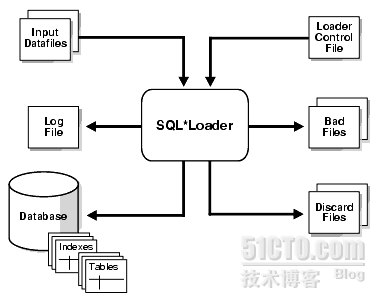Sql*loader
Oracle 11.2
用法: SQLLDR keyword=value [,keyword=value,...]
有效的关键字:
userid -- ORACLE 用户名/口令
control -- 控制文件名
log -- 日志文件名
bad -- 错误文件名
data -- 数据文件名
discard -- 废弃文件名
discardmax -- 允许废弃的文件的数目 (全部默认)
skip -- 要跳过的逻辑记录的数目 (默认 0)
load -- 要加载的逻辑记录的数目 (全部默认)
errors -- 允许的错误的数目 (默认 50)
rows -- 常规路径绑定数组中或直接路径保存数据间的行数
(默认: 常规路径 64, 所有直接路径)
bindsize -- 常规路径绑定数组的大小 (以字节计) (默认 256000)
silent -- 运行过程中隐藏消息 (标题,反馈,错误,废弃,分区)
direct -- 使用直接路径 (默认 FALSE)
parfile -- 参数文件: 包含参数说明的文件的名称
parallel -- 执行并行加载 (默认 FALSE)
file -- 要从以下对象中分配区的文件
skip_unusable_indexes -- 不允许/允许使用无用的索引或索引分区 (默认 FALSE)
skip_index_maintenance -- 没有维护索引, 将受到影响的索引标记为无用 (默认 FALSE)
commit_discontinued -- 提交加载中断时已加载的行 (默认 FALSE)
readsize -- 读取缓冲区的大小 (默认 1048576)
external_table -- 使用外部表进行加载;NOT_USED, GENERATE_ONLY, EXECUTE (默认 NO
T_USED)
columnarrayrows -- 直接路径列数组的行数 (默认 5000)
streamsize -- 直接路径流缓冲区的大小 (以字节计) (默认 256000)
multithreading -- 在直接路径中使用多线程
resumable -- 启用或禁用当前的可恢复会话 (默认 FALSE)
resumable_name -- 有助于标识可恢复语句的文本字符串
resumable_timeout -- RESUMABLE 的等待时间 (以秒计) (默认 7200)
date_cache -- 日期转换高速缓存的大小 (以条目计) (默认 1000)
no_index_errors -- 出现任何索引错误时中止加载 (默认 FALSE)
PLEASE NOTE: 命令行参数可以由位置或关键字指定
。前者的例子是 'sqlldr
scott/tiger foo'; 后一种情况的一个示例是'sqlldr control=foo
userid=scott/tiger'。位置指定参数的时间必须早于
但不可迟于由关键字指定的参数。例如,
允许 'sqlldr scott/tiger control=foo logfile=log', 但是
不允许 'sqlldr scott/tiger control=foo log', 即使
参数 'log' 的位置正确。
参数的OPTIONS Clause
specify command-line parameters in theSQL*Loader control file using the OPTIONS clause. This can be useful when youtypically invoke a control file with the same set of options. The OPTIONSclause precedes the LOAD DATA statement.
BINDSIZE = n
COLUMNARRAYROWS = n
DATE_CACHE = n
DIRECT = {TRUE | FALSE}
ERRORS = n
EXTERNAL_TABLE = {NOT_USED | GENERATE_ONLY | EXECUTE}
FILE
LOAD = n
MULTITHREADING = {TRUE | FALSE}
PARALLEL = {TRUE | FALSE}
READSIZE = n
RESUMABLE = {TRUE | FALSE}
RESUMABLE_NAME = 'text string'
RESUMABLE_TIMEOUT = n
ROWS = n
SILENT = {HEADER | FEEDBACK | ERRORS | DISCARDS | PARTITIONS | ALL}
SKIP = n
SKIP_INDEX_MAINTENANCE = {TRUE | FALSE}
SKIP_UNUSABLE_INDEXES = {TRUE | FALSE}
STREAMSIZE = n
实例:
sqlldr userid=user/passwordcontrol=vav_dvd_config.ctl log=test.log
如果连接远程服务器如下:
sqlldr control=vav_dvd_config.ctllog=test.log
Username:name@dbinstance
Password:password
在这里的dbinstance 是oracle客户端中的tnsname.ora文件描述的连接字符串名称。
Sql*loader of Overview.
A typical SQL*Loader session takes as inputa control file, which controls the behavior of SQL*Loader, and one or more datafiles. The output of SQL*Loader is an Oracle database (where the data isloaded), a log file, a bad file, and potentially, a discard file. An example ofthe flow of a SQL*Loader session is shown
上图是sqlldr常用的几个文件。下来解释下这几个文件:
1、controlfile
The SQL*Loader control file is a text filethat contains data definition language (DDL) instructions. DDL is used tocontrol the following aspects of a SQL*Loader session:
Where SQL*Loader will find the data to load
How SQL*Loader expects that data to beformatted
How SQL*Loader will be configured (memorymanagement, rejecting records, interrupted load handling, and so on) as itloads the data
How SQL*Loader will manipulate the databeing loaded
例如:
1 -- This is a sample control file
2 LOAD DATA
3 INFILE'sample.dat'
4 BADFILE 'sample.bad'
5 DISCARDFILE 'sample.dsc'
6 APPEND
7 INTO TABLE emp
8 WHEN (57) = '.'
9 TRAILING NULLCOLS
10 (hiredate SYSDATE,
deptno POSITION(1:2) INTEGER EXTERNAL(2)
NULLIF deptno=BLANKS,
job POSITION(7:14) CHAR TERMINATED BY WHITESPACE
NULLIF job=BLANKS "UPPER(:job)",
mgr POSITION(28:31) INTEGER EXTERNAL
TERMINATED BYWHITESPACE, NULLIF mgr=BLANKS,
ename POSITION(34:41) CHAR
TERMINATED BY WHITESPACE "UPPER(:ename)",
empno POSITION(45) INTEGER EXTERNAL
TERMINATED BYWHITESPACE,
sal POSITION(51) CHAR TERMINATED BY WHITESPACE
"TO_NUMBER(:sal,'$99,999.99')",
comm INTEGER EXTERNAL ENCLOSED BY '(' AND '%'
":comm *100"
)
这是一个简单的例子,数字1到10在实际脚本中是不写的。下面对这个例子进行说明:
1、略
2、Load date 告诉 sql*loader 开始数据装载
3、Inflie是要load的文件名称,里面是数据表的内容。文件可以是txt,csv等常用格式。
4、Badfile是装载过程中被拒绝的数据被存放在badfile中。
5、Discardfile 是装载过程中丢弃的记录存在discardfile中
6、Append是对非空表中数据保持不变,然后继续插入数据。例子中Emp表是非空表,那么sqlloader导入时,会在原有的数据的基础上导入数据。
7、Into table 是指定导入对象,字段以及字段类型。关联操作系统文件中的记录和数据库表之间。
8、When 语句是指定限制条件如’,’ or ‘.’ ,在CSV中会以,号来区别开来。那么数据会做遇到“,”就会插入到对表中的列字段中去。
9、Trailing nullcols 是在相对应表中的列,如果没有数据记录则表示代表为null columns
10、包含是关于表中的列字段的部分,这里经常会用到列段的格式问题。
当然sql*loader中还有很多参数,在这里就不提了。这里只讲讲常用的参数。例如:
lFILE (tablespace file to load into)
Default: none
FILE specifies the database file toallocate extents from. It is used only for direct path parallel loads. Byvarying the value of the FILE parameter for different SQL*Loader processes,data can be loaded onto a system with minimal disk contention.
lLOG (log file)
Default: The name of the control file, withan extension of .log.
LOG specifies the log file that SQL*Loaderwill create to store logging information about the loading process.
lMULTITHREADING
Default: true on multiple-CPU systems,false on single-CPU systems
This parameter is available only for directpath loads.
By default, the multithreading option isalways enabled (set to true) on multiple-CPU systems. In this case, thedefinition of a multiple-CPU system is a single system that has more than oneCPU.
On single-CPU systems, multithreading isset to false by default. To use multithreading between two single-CPU systems,you must enable multithreading; it will not be on by default. This will allowstream building on the client system to be done in parallel with stream loadingon the server system.
Multithreading functionality is operatingsystem-dependent. Not all operating systems support multithreading.
lPARALLEL (parallel load)
Default: false
PARALLEL specifies whether direct loads canoperate in multiple concurrent sessions to load data into the same table.
等等。在面对导入大数据量的时候,需要重新考虑下参数的应用。比如:并行,表索引等等。所以说在面对不同的数据量时,大家选择的参数文件可能不一样。
参考文档:
http://docs.oracle.com/cd/E11882_01/server.112/e22490/ldr_control_file.htm#i1005907
SQL*Loader control file reference
http://docs.oracle.com/cd/E11882_01/server.112/e22490/ldr_params.htm#i1004682
SQL*Loader Command-Line Reference
http://docs.oracle.com/cd/E11882_01/server.112/e22490/ldr_concepts.htm#i1006494
SQL*Loader Concepts
转载于:https://blog.51cto.com/worms/1247131





















 1万+
1万+











 被折叠的 条评论
为什么被折叠?
被折叠的 条评论
为什么被折叠?








